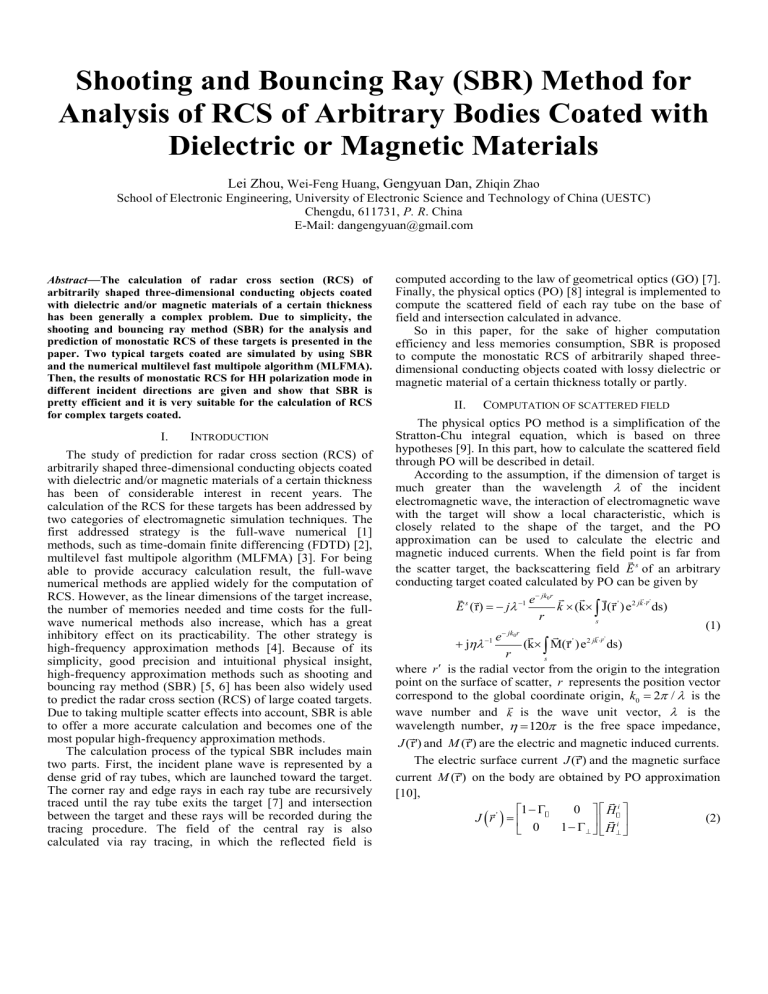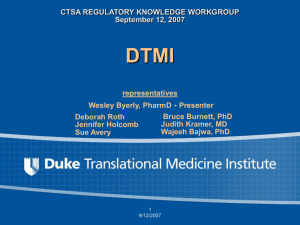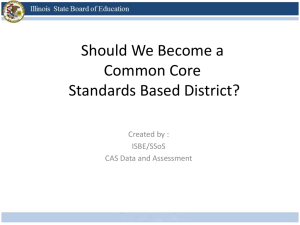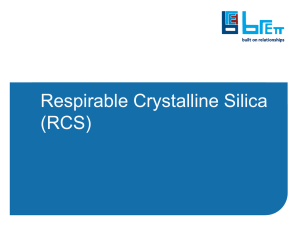Paper Title (use style: paper title)

Shooting and Bouncing Ray (SBR) Method for
Analysis of RCS of Arbitrary Bodies Coated with
Dielectric or Magnetic Materials
Lei Zhou,
Wei-Feng Huang
, Gengyuan Dan,
Zhiqin Zhao
School of Electronic Engineering, University of Electronic Science and Technology of China (UESTC)
Chengdu, 611731, P. R . China
E-Mail: dangengyuan@gmail.com
Abstract
—
The calculation of radar cross section (RCS) of arbitrarily shaped three-dimensional conducting objects coated with dielectric and/or magnetic materials of a certain thickness has been generally a complex problem. Due to simplicity, the shooting and bouncing ray method (SBR) for the analysis and prediction of monostatic RCS of these targets is presented in the paper. Two typical targets coated are simulated by using SBR and the numerical multilevel fast multipole algorithm (MLFMA).
Then, the results of monostatic RCS for HH polarization mode in different incident directions are given and show that SBR is pretty efficient and it is very suitable for the calculation of RCS for complex targets coated. computed according to the law of geometrical optics (GO) [7].
Finally, the physical optics (PO) [8] integral is implemented to compute the scattered field of each ray tube on the base of field and intersection calculated in advance.
So in this paper, for the sake of higher computation efficiency and less memories consumption, SBR is proposed to compute the monostatic RCS of arbitrarily shaped threedimensional conducting objects coated with lossy dielectric or magnetic material of a certain thickness totally or partly.
II.
C OMPUTATION OF SCATTERED FIELD
I.
I NTRODUCTION
The study of prediction for radar cross section (RCS) of arbitrarily shaped three-dimensional conducting objects coated with dielectric and/or magnetic materials of a certain thickness has been of considerable interest in recent years. The calculation of the RCS for these targets has been addressed by two categories of electromagnetic simulation techniques. The first addressed strategy is the full-wave numerical [1] methods, such as time-domain finite differencing (FDTD) [2], multilevel fast multipole algorithm (MLFMA) [3]. For being able to provide accuracy calculation result, the full-wave numerical methods are applied widely for the computation of
RCS. However, as the linear dimensions of the target increase, the number of memories needed and time costs for the fullwave numerical methods also increase, which has a great inhibitory effect on its practicability. The other strategy is high-frequency approximation methods [4]. Because of its simplicity, good precision and intuitional physical insight, high-frequency approximation methods such as shooting and bouncing ray method (SBR) [5, 6] has been also widely used to predict the radar cross section (RCS) of large coated targets.
Due to taking multiple scatter effects into account, SBR is able to offer a more accurate calculation and becomes one of the most popular high-frequency approximation methods.
The calculation process of the typical SBR includes main two parts. First, the incident plane wave is represented by a dense grid of ray tubes, which are launched toward the target.
The corner ray and edge rays in each ray tube are recursively traced until the ray tube exits the target [7] and intersection between the target and these rays will be recorded during the tracing procedure. The field of the central ray is also calculated via ray tracing, in which the reflected field is
The physical optics PO method is a simplification of the
Stratton-Chu integral equation, which is based on three hypotheses [9]. In this part, how to calculate the scattered field through PO will be described in detail.
According to the assumption, if the dimension of target is much greater than the wavelength
of the incident electromagnetic wave, the interaction of electromagnetic wave with the target will show a local characteristic, which is closely related to the shape of the target, and the PO approximation can be used to calculate the electric and magnetic induced currents. When the field point is far from the scatter target, the backscattering field E s of an arbitrary conducting target coated calculated by PO can be given by
E s
(r)
j
1 e
r
' 2
'
(k M(r ) e ds) s k
' 2
'
(k J(r ) e ds) s
(1) e
j
1 r where r
is the radial vector from the origin to the integration point on the surface of scatter, r represents the position vector correspond to the global coordinate origin, k
0
2 / is the wave number and k is the wave unit vector, wavelength number,
120
is the
is the free space impedance,
J (r') and M (r') are the electric and magnetic induced currents.
The electric surface current (r') and the magnetic surface current M (r') on the body are obtained by PO approximation
[10],
1
0
0 1
H i
H i
(2)
E i
(3) where E i and H i denote the incident electric field and magnetic field , respectively. H i
is the parallel component of
H i and H i
represents the perpendicular component of H i , n is the unit normal vector to the surface, Z is the relative surface impedance.
The relative surface impedance can be written as [11]: where
Z
j
r tan
r r
(4) r
is the complex relative permittivity and r
r
is the complex relative permeability, k
0
is the propagation constant of the free space and d is the thickness of the homogeneous material coated layer.
and
are the Snell reflection coefficients for parallel and perpendicular polarizations.
and
can be calculated by the following formula
[10]: where
Z
Z
cos cos
(5)
Z
Z
sec sec
(6)
is the included angle between unit normal vector n of target and the reverse direction of the propagation direction of the electromagnetic wave.
III.
RESULTS AND DISCUSSIONS
In this part, two typical models are applied to compute their monostatic RCS characteristics using SBR and MLFMA at 2
GHz. Since the results for both polarizations show a similar characteristic, only RCS in HH-polarization will be analyzed.
In addition, all the simulation results got by SBR and MLFMA are performed on the Dell Precision workstation T7500 with
Intel(R) Xeon(R) CPU W5590 3.33GHz and only one processor has been used for these simulations.
A.
PEC Plane Coated with Lossy Dielectric Material
The first validation target is a simple PEC plane coated with lossy dielectric material as shown in Fig. 1. The size of the plane is is 0.01
20
20
and the thickness of the coated layer
. The permittivity and permeability of the coated material are
r
32.6
j 0.48
and
r
5.8
j 0.29
, respectively. The monostatic RCS of the PEC plane is evaluated in the plane x-z at angular increments of 1 . The
RCS curves of SBR and the classical MLFMA are shown in
Fig. 2. In Fig. 2, it is observed that RCS values obtained by
SBR for the PEC plane coated with lossy dielectric material agree well with those by MLFMA. Only in large angle scattering area, the RCS results by SBR are inaccurate with those by MLFMA.
In cid
W av en e t E
M
X
Z
O
20λ
Y
20
λ
0.01λ
Fig. 1. Geometry of the PEC plane coated with lossy dielectric material.
40
SBR
MLFMA
30
20
10
0
-10
-20
0 10 20 30
Φ(deg)
40 50 60
Fig. 2. Monostatic RCS of the plate coated with lossy dielectric material.
B.
Dihedral Corner Reflector Coated with Lossy Dielectric
Material
The second validation target is a dihedral corner reflector.
In this paper, the dihedral corner reflector coated with lossy dielectric material is constructed of two planes with a size
20
20
20
and a thickness of 0.01
and shown in Fig. 3.
The permittivity and permeability of the material coated are
r
4.0
j 3.0
and
r
4.0
j 3.3
. The monostatic RCS of the dihedral corner reflector is computed at incident angles
0 90 and
90 with an angular resolution of 1 . The
RCS curves of MLFMA and SBR are shown in Fig. 4.
Obviously, results of SBR shown in Fig.4 matches pretty well with the ones of MLFMA.
0.01λ In order to demonstrate the higher computation efficiency and less memories consumption of SBR, (compared with
MLFMA) the computation time and memories usage of SBR and MLFMA for two models are listed in Table I. From the table 1, the total computation time and memories usage of
SBR for two models are far less than ones of MLFMA.
PEC
In ci de nt
E
M
W av e
IV.
C ONCLUSION
20λ
Z
Coated Layer
X
The SBR applied to calculate RCS of arbitrarily shaped three-dimensional conducting objects coated with a certain thickness has been described detailedly in this paper. Two typical targets with coated layer are simulated for RCS calculation by applying SBR and MLFMA, respectively.
According to the comparison between the results of SBR and
MLFMA, it can be concluded that SBR can achieve the same accuracy by costing far less computation time and memories.
Therefore, SBR is a very effective technique for the RCS
20λ dielectric material.
TABLE I
Information about computation time and memories usage of SBR and
MLFMA
PEAK
Plane
(SBR)
MEMORY
( MB)
14.96
CPU TIME
(seconds)
35911 calculation of large arbitrarily shaped three-dimensional conducting objects coated with dielectric and/or magnetic
Fig. 3. Geometry of the dihedral corner reflector coated with lossy dielectric material.
45
SBR
40
35
30
25
20
15
0 10 20 30 40 50
Φ(deg)
60 70 80 90
Fig. 4. Monostatic RCS of the dihedral corner reflector coated with lossy
Plane
(MLFMA) dihedral corner reflector (SBR) dihedral corner reflector (MLFMA)
1570.816
20.02
3581.952
MLFMA
3637.915
96.768
8106.630 materials of a certain thickness.
R EFERENCES
[1] W. C. Chew and L. J. Jiang, “Overview of large-scale computing: The past, the present, and the future,”
Proc. IEEE , vol. 101, no. 2, pp. 227–
241, 2013.
[2] Taflove, A., and Umashankar, K.: ‘Radar cross-section of general
threedimensional scatterers’, IEEE Trans. Electromagn. Compat., 25, pp.
682–699,1983.
[3] W. C. Chew and L. J. Jiang, “Overview of large-scale computing: The past, the present, and the future,” Proc. IEEE, vol. 101, no. 2, pp. 227–
241, 2013.
[4] Garcia-Donoro, D., I. Martinez-Fernandez, L. E. Garcia-Castillo, Y.
Zhang, and T. K. Sarkar,”RCS computation using a parallel in-core and out-of-core direct solver," Progress In Electromagnetics Research, Vol.
118, 505-525, 2011.
[5] Ling, H., R. C. Chou, and S. W. Lee, “Shooting and bouncing rays: calculating the RCS of an arbitrarily shaped cavity,” IEEE Transaction on Antenna and Propagation, Vol. 37, No. 2, 194–205, 1989.
[6] Baldauf, J.S. W. Lee, L. Lin, S. K. Jeng, S. M. Scarborough, and C. L.
Yu, “High frequency scattering from trihedral corner reflectors and other benchmark targets: SBR vs. experiments,”IEEE Transaction on Antenna and Propagation, Vol. 39, No. 9, 1345–1351, 1991.
[7] Ling, H., R. C. Chou, and S. W. Lee, “Shooting and bouncing rays: calculating the RCS of an arbitrarily shaped cavity,” IEEE Transaction on Antenna and Propagation, Vol. 37, No. 2, 194–205, 1989.
[8] F. A. Jenkin, H. E. White. Fundamentals of Physical Optics. New York:
McGraw-Hill, 1957.
[9] [9] E. F. Knott, J. F. Shaeffer, and M. T. Tuley, Radar Cross Section, 2nded.
Raleigh: SciTech Publishing, 2004.
[10] Ruck, G.T., Barrick, D.E., Stuart, W.D., and Krichbaum, D.K.: ‘Radar cross section handbook’ (Plenum, 1970)
[11] J.M.Song, C.C.Lu, W.C.Chew, and S.W.Lee. Fast Illinois Solver Code
(FISC), IEEE Transactions on Antennas and Propagation,, 40(3):27-34,
1998.








